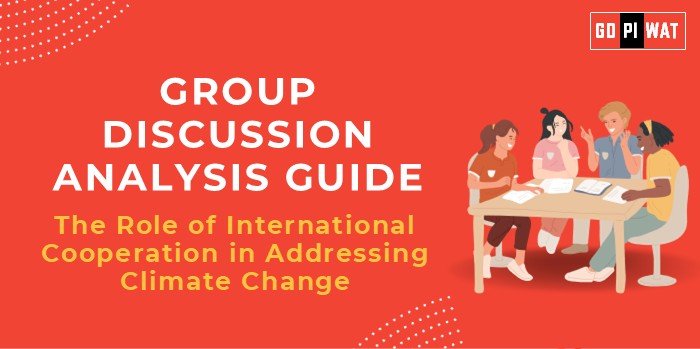📋 Group Discussion Analysis Guide
🌍 The Role of International Cooperation in Addressing Climate Change
🌐 Introduction
- Context: Climate change, a pressing global challenge, demands coordinated efforts beyond national borders due to its transnational impacts.
- Background: Originating from the recognition of global warming in the 1980s, international cooperation took center stage with milestones like the Kyoto Protocol (1997) and the Paris Agreement (2015). The IPCC warns that limiting global warming to 1.5°C requires unprecedented collaboration.
📊 Quick Facts and Key Statistics
- 🌎 Global Greenhouse Gas Emissions: 37 billion tons annually—energy sector as the largest contributor.
- 🌱 Paris Agreement Participation: 195 nations; net-zero pledges by over 130 countries.
- 🌳 Deforestation Rates: 10 million hectares annually—highlighting the need for global conservation efforts.
- ⚡ Renewable Energy Investment: $1.3 trillion in 2022, showing a growing shift toward sustainability.
- 🌊 IPCC Reports: Projected sea level rise of up to 1 meter by 2100 without mitigation.
👥 Stakeholders and Their Roles
- Governments: Develop policies, enforce regulations, and participate in global agreements (e.g., US Inflation Reduction Act).
- International Organizations: Coordinate efforts (e.g., UNFCCC, World Bank).
- Corporations: Innovate and adopt sustainable practices (e.g., renewable energy production).
- Civil Society: Advocate for accountability and awareness (e.g., Fridays for Future).
🏆 Achievements and Challenges
✨ Achievements:
- 🌍 Paris Agreement: Unified global commitment to limit warming.
- ⚡ Global Renewable Growth: Wind and solar energy doubled in the past decade.
- 💰 Green Climate Fund: Mobilized $10 billion for developing nations.
⚠️ Challenges:
- 💸 Funding Gaps: Estimated $4 trillion annual requirement for energy transition.
- 🌐 Disparities: Developing nations contribute least but face disproportionate impacts.
- ❌ Non-Compliance: Major emitters often fall short of pledges (e.g., COP27 criticisms).
🌎 Global Comparisons:
- ✅ Success: EU’s Emissions Trading Scheme.
- ❌ Challenges: US-China cooperation remains limited by geopolitical tensions.
🗂️ Structured Arguments for Discussion
- 💪 Supporting Stance: “The Paris Agreement demonstrates the potential of collective action, with countries committing to transparent and ambitious climate goals.”
- ❓ Opposing Stance: “Despite agreements, global emissions continue to rise, highlighting enforcement gaps and political inertia.”
- ⚖️ Balanced Perspective: “International cooperation has catalyzed progress, but disparities in commitment and resources hinder impactful outcomes.”
💡 Effective Discussion Approaches
- Opening Techniques:
- 🌡️ Present a striking fact: “Global warming has caused a 1.2°C temperature rise since pre-industrial levels.”
- 📜 Use a case study: “The EU’s carbon border tax exemplifies international policy innovation.”
- Counter-Argument Handling:
- Reframe disparities as opportunities for targeted action.
- Highlight successful collaborations like the Kigali Amendment on HFCs.
🔎 SWOT Analysis
- ✅ Strengths: Broad participation in global accords, rising public and corporate awareness.
- ❌ Weaknesses: Insufficient funding and technology sharing.
- ✨ Opportunities: Expansion of carbon markets, integration of AI for monitoring compliance.
- ⚠️ Threats: Political instability and non-binding agreements.
📚 Connecting with B-School Applications
- Real-World Applications: Projects on carbon markets, sustainable finance, or global supply chain adaptations.
- Sample Questions:
- “How can businesses align with international climate targets?”
- “Discuss the role of financial instruments in combating climate change.”
- Insights: Understand mechanisms like carbon credits, and engage in green policy discussions during internships.


